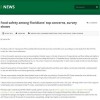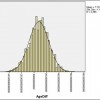 Wrapping up the Savvy Survey Series, this fact sheet is the last of three publications that outline procedures to follow after implementing a survey. With the surveys in, data collected, and analyses conducted, the next logical step deals with communicating the results. Through communication, ideas and thoughts are shared with others in a manner that will be easily understood. In Extension, some common communication channels include the annual Report of Accomplishment (ROA), grant project reports, abstracts, and oral presentations. This 5-page fact sheet was written by Milton G. Newberry, III, Jessica L. Gouldthorpe, and Glenn D. Israel, and published by the UF Department of Agricultural Education and Communication, September 2014.
Wrapping up the Savvy Survey Series, this fact sheet is the last of three publications that outline procedures to follow after implementing a survey. With the surveys in, data collected, and analyses conducted, the next logical step deals with communicating the results. Through communication, ideas and thoughts are shared with others in a manner that will be easily understood. In Extension, some common communication channels include the annual Report of Accomplishment (ROA), grant project reports, abstracts, and oral presentations. This 5-page fact sheet was written by Milton G. Newberry, III, Jessica L. Gouldthorpe, and Glenn D. Israel, and published by the UF Department of Agricultural Education and Communication, September 2014.
http://edis.ifas.ufl.edu/pd081
Tag: Milton G. Newberry
The Savvy Survey #16: Data Analysis and Survey Results
 Continuing the Savvy Survey Series, this fact sheet is one of three focused on working with your survey data. In its most raw form, the data collected from surveys do not tell much of a story except who completed the survey, partially completed it, or did not respond at all. To truly interpret the data, it must be analyzed. Where does one begin the data analysis process? What computer program(s) can be used to analyze data? How should the data be analyzed? This publication serves to answer these questions. This 7-page fact sheet was written by Milton G. Newberry, III, Jessica L. Gouldthorpe, and Glenn D. Israel, and published by the UF Department of Agricultural Education and Communication, August 2014.
Continuing the Savvy Survey Series, this fact sheet is one of three focused on working with your survey data. In its most raw form, the data collected from surveys do not tell much of a story except who completed the survey, partially completed it, or did not respond at all. To truly interpret the data, it must be analyzed. Where does one begin the data analysis process? What computer program(s) can be used to analyze data? How should the data be analyzed? This publication serves to answer these questions. This 7-page fact sheet was written by Milton G. Newberry, III, Jessica L. Gouldthorpe, and Glenn D. Israel, and published by the UF Department of Agricultural Education and Communication, August 2014.
http://edis.ifas.ufl.edu/pd080
The Savvy Survey #15: Survey Responses and Data Entry
 This publication discusses the procedures for entering paper-based survey responses into an electronic database and preparing (or “cleaning”) all data, regardless of mode, for analysis. It also addresses data entry considerations for closed-ended questions (with response choices), partially-closed questions, and open-ended questions, since the types of questions used in the survey will also impact the data entry process.This 5-page fact sheet was written by Milton G. Newberry, III, Jessica L. Gouldthorpe, and Glenn D. Israel, and published by the UF Department of Agricultural Education and Communication, August 2014.
This publication discusses the procedures for entering paper-based survey responses into an electronic database and preparing (or “cleaning”) all data, regardless of mode, for analysis. It also addresses data entry considerations for closed-ended questions (with response choices), partially-closed questions, and open-ended questions, since the types of questions used in the survey will also impact the data entry process.This 5-page fact sheet was written by Milton G. Newberry, III, Jessica L. Gouldthorpe, and Glenn D. Israel, and published by the UF Department of Agricultural Education and Communication, August 2014.
http://edis.ifas.ufl.edu/pd079